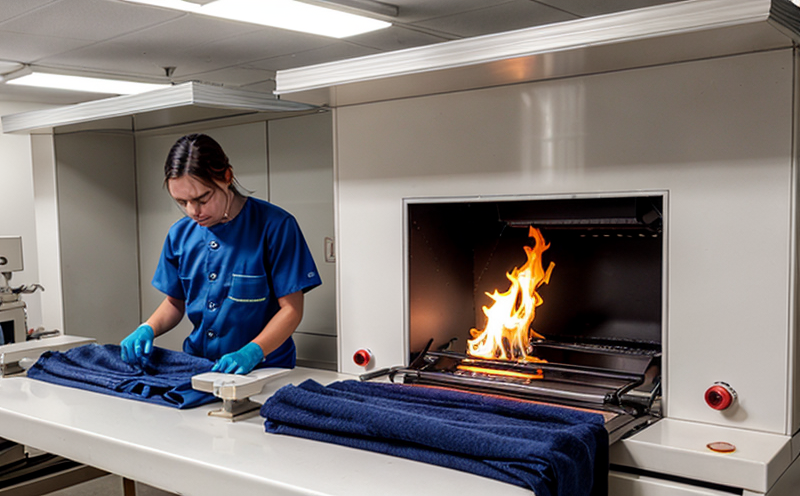Reaction-to-Fire Testing for Textile Laminates
The Reaction-to-Fire (RFT) testing of textile laminates is a critical component in ensuring that materials used within various sectors meet stringent safety and regulatory requirements. This service involves assessing how textiles react to fire, including their ignition behavior, flame spread characteristics, and post-flame performance. Textile laminates are composite materials made from multiple layers, often used in applications such as automotive interiors, furniture upholstery, and protective clothing.
The primary goal of RFT testing is to evaluate the combustibility and flammability properties of these materials to ensure they comply with safety standards and regulations. This service typically involves several key steps: sample preparation, specimen conditioning, ignition source application, flame propagation measurement, heat release rate determination, and post-test analysis.
The apparatus used in RFT testing includes specialized equipment such as cone calorimeters (ASTM E648), oxygen index testers (ISO 13967-2), and thermogravimetric analyzers. The acceptance criteria for textile laminates are based on specific limits set by international standards, such as ISO 17795-2:2020 or ASTM E648-18.
Sample preparation is critical to the success of RFT testing. Samples must be conditioned according to specified environmental conditions (temperature and humidity) prior to testing. This ensures that all samples are in a consistent state, which is crucial for obtaining accurate results. The specimens are then cut into standard sizes suitable for the specific test method being used.
During ignition source application, the sample is subjected to heat or flame under controlled conditions. The apparatus measures various parameters such as peak heat release rate (PHRR), total heat released during flaming combustion, and smoke production index (SPI). Post-test analysis involves examining char depth, melt patterns, and other physical changes in the material.
The results of RFT testing are reported using standardized formats that include graphical representations of test data along with numerical values. These reports serve as valuable tools for quality assurance teams, compliance officers, and R&D engineers to ensure product safety and regulatory compliance. Compliance with international standards such as ISO 17795-2:2020 ensures consistency across different jurisdictions.
Quality assurance in Reaction-to-Fire testing is paramount to maintaining the integrity of the test results. Key factors include proper sample preparation, consistent environmental conditions, accurate measurement techniques, and thorough post-test analysis. Regular calibration of equipment and training of personnel are essential for ensuring reliable outcomes.
| Parameter | Value |
|---|---|
| Temperature Range (°C) | 100-450°C |
| Flame Height (mm) | 25±5 mm |
| Oxygen Concentration (%) | 21±1% |
| Application | Description |
|---|---|
| Automotive Interior | Evaluating fire resistance of seat covers and door panels. |
| Furniture Upholstery | Ensuring compliance with flammability regulations for furniture fabrics. |
| Protective Clothing | Determining the flame retardant properties of garments used in high-risk environments. |
Quality and Reliability Assurance
- Consistent sample preparation
- Environmental conditioning to specified standards
- Calibration of testing equipment
- Trained personnel conducting tests
- Accurate measurement techniques
- Thorough post-test analysis
- Regular calibration checks on apparatus
- Adherence to international standards and regulations
Customer Impact and Satisfaction
The results of Reaction-to-Fire testing are essential for quality managers, compliance officers, R&D engineers, and procurement teams. By providing accurate data on the flammability properties of textile laminates, this service helps companies meet regulatory requirements and improve product safety. This leads to enhanced customer satisfaction as consumers can be assured that the products they purchase comply with rigorous safety standards.
Compliance with international standards such as ISO 17795-2:2020 ensures consistency across different jurisdictions, which is particularly important for multinational corporations operating in multiple countries. This service supports sustainable business practices by helping companies avoid costly recalls and legal disputes related to product safety issues.
Use Cases and Application Examples
The Reaction-to-Fire testing of textile laminates has numerous applications across various sectors, including automotive, furniture manufacturing, and protective clothing. Here are some specific use cases:
| Application | Description |
|---|---|
| Automotive Interior | Evaluating fire resistance of seat covers and door panels. |
| Furniture Upholstery | Ensuring compliance with flammability regulations for furniture fabrics. |
| Protective Clothing | Determining the flame retardant properties of garments used in high-risk environments. |
In the automotive industry, textile laminates are often used in seat covers and door panels. Reaction-to-Fire testing helps manufacturers ensure that these materials meet stringent safety standards to protect occupants in case of a fire. In furniture manufacturing, compliance with flammability regulations is crucial for maintaining product quality and preventing recalls.
For protective clothing applications, the flame retardant properties of textile laminates are tested to ensure they can withstand exposure to flames or other ignition sources without igniting readily or burning excessively. This service supports sustainable business practices by helping companies avoid costly recalls and legal disputes related to product safety issues.





